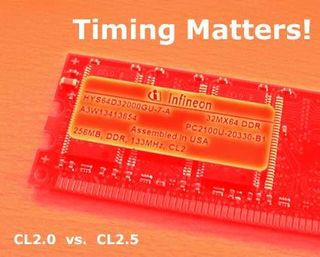Perfect Timing: DDR Performance Analysis
Introduction
Perfect Timing: DDR Performance Analysis

It's a never-ending story: the media strongly recommends the use of fast memory, while in the meantime many computers sold in the big retail stores are factory-equipped with cheap and slow memory, thus hampering the performance of supposedly "modern" computer systems. Are we being sold nothing more than junk? Or is the performance gap simply much smaller than we thought?
There are some core components that are responsible for the overall performance of a computer; these are, namely, the processor, the hard drive, the graphics card and, last but not least, the chipset, including the memory controller. But there is no sense in buying premium hardware if even one component remains below average. One popular strategy among system integrators is to use cheap memory. Modules that only run at CL3 (SDRAM) or CL2.5 (DDR) are usually slightly cheaper than DIMMs for CL2.
There's no question that CL2 has a performance advantage over slower modes, but what does the difference look like in the real world? This article takes a look at four different memory settings, ranging from the absolute minimum to the most optimal using an up-to-date Pentium 4 system.
Stay on the Cutting Edge
Join the experts who read Tom's Hardware for the inside track on enthusiast PC tech news — and have for over 25 years. We'll send breaking news and in-depth reviews of CPUs, GPUs, AI, maker hardware and more straight to your inbox.
Most Popular

